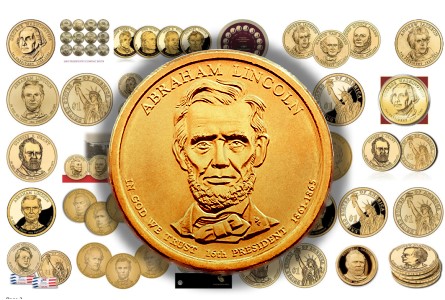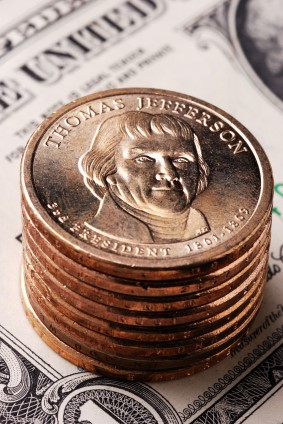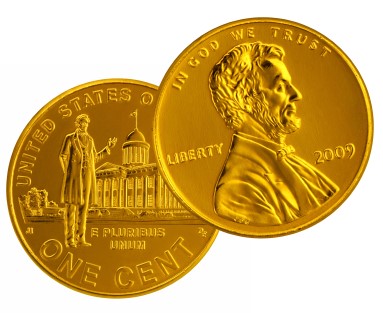by Louis Golino for CoinWeek ……
On November 29 the Domestic Monetary Policy Subcommittee of the House Committee on Financial Services, which is headed by outgoing Chairman Ron Paul, held a hearing on “The Future of Money: Dollars and Sense” that examined in detail the issues surrounding the replacement of paper dollars with coins and some related issues concerning coins.
The main highlights of the hearing were as follows. The U.S. Mint reported that circulating coin production increased substantially over the past year, while numismatic and bullion coin sales decline sharply.
 The Government Accountability Office reiterated its conclusions from February of this year that replacing dollar notes with coins would save $4.4 billion over 30 years but added some qualifications to its analyses based on issues such as the cost to ramp up production of $1 coins in the aftermath of the move last December to stop producing these coins except for numismatic sales.
The Government Accountability Office reiterated its conclusions from February of this year that replacing dollar notes with coins would save $4.4 billion over 30 years but added some qualifications to its analyses based on issues such as the cost to ramp up production of $1 coins in the aftermath of the move last December to stop producing these coins except for numismatic sales.
The Canadian Mint’s chief operating officer drew from her country’s experience with dollar and two dollar coins and coins made of multi-ply plated steel as well as cutting-edge coin production technologies.
Former Mint Director Philip Diehl made the case for replacing dollar notes with coins, drawing from his experience when the Sacagawea coins were launched in 2000, while former Office of Management and Budget Director James Miller made the case against dollar coins, and Mark Weller explained why cents should be made of steel.
Witnesses for the first panel included Acting Director of the U.S. Mint Richard Peterson, Lorelei St. James, head of the physical infrastructure team at the Government Accountability Office, and Beverly Lepine, the chief operating officer of the Royal Canadian Mint.
Acting Director of the U.S. Mint, Richard Peterson, discussed the decrease in revenue in the Mint’s numismatic and bullion coin programs, the research and development program the Mint has been using to explore metallic alternatives to the current metals used in circulating coinage, and said that in December the Mint will issue its first annual report on the findings of the R&D program, which is a result of provisions in the Coinage Modernization, Oversight, and Continuity Act of 2010.
Circulating coin production increased 24% over the past year from 7.4 to 9.2 billion coins. It has grown 20% a year over the past three years since a low reached in 2009 at the height of the recent economic crisis.
 Despite the fact that the cost to produce the penny and nickel “exceeded their face values again, just as they have for each of the last six years,” circulating coinage production costs decreased 25% over the past three years through the use of greater efficiency in production. Director Petersen also noted that seigniorage [which is the difference between the face value of a coin and the cost to produce and distribute it -LG] was positive for fiscal year 2012.
Despite the fact that the cost to produce the penny and nickel “exceeded their face values again, just as they have for each of the last six years,” circulating coinage production costs decreased 25% over the past three years through the use of greater efficiency in production. Director Petersen also noted that seigniorage [which is the difference between the face value of a coin and the cost to produce and distribute it -LG] was positive for fiscal year 2012.
He did not provide specifics on either seigniorage or the cost to make pennies and nickels, but these will presumably be included in the Mint’s annual report to congress for the past fiscal year, which should be available soon.
As far as bullion sales, the Mint sold 788,000 ounces of gold and 34.1 million ounces of silver, but net income decreased 57% “because of lower volumes and pricing.”
The Mint held meetings with its network of authorized purchasers to assess market trends and discuss “more effective and efficient bullion coin operations and to improve communication between the Mint and the private sector.”
Numismatic sales, which were up sharply in 2011, declined substantially in the past year because of “moderating silver prices, only one American Eagle Proof coin release, and a later-than-usual sale date for our recurring sets,” resulting in a revenue decrease of $241 million. I found the mention of one proof silver eagle coin release odd since the Mint actually issued two proof silver eagles in 2012, one made in West Mint, and one made in San Francisco. This article is based on prepared remarks, and it is possible this was corrected when he spoke before the subcommittee.
Finally, Director Peterson discussed dollar coins. He repeated the figure released last year that suspending production of dollar coins except for numismatic sales saved $50 million in production costs, but did not discuss the loss in seigniorage income from that move. He also said two trial strikes were done to test the hardness, ductility, corrosion and wear resistance, etc. of alterative metals for circulating coins.
GAO official Lorelei St. James reiterated the agency’s previously stated view that moving from dollar notes to coins “is likely to provide a financial benefit to the government if the note is eliminated and negative public reaction is effectively managed through stakeholder outreach and publication.” Stakeholder outreach means working with companies that make vending machines and so forth. In its February 2012 report the GAO pointed out that the “overall net benefit [of using coins instead of notes] was due solely to increased seigniorage and not to reduced production costs,” which would seem to contradict what the Acting Mint Director stated in his remarks about production cost savings.
 The GAO essentially updated its analysis that covers a 30 year period, which now finds that during the first ten years costs actually increase because of the need to ramp up production after ceasing production last year except for a limited number of dollar coins sold to collectors. In addition, it is hard to estimate the future demand for money in an era when more and more people use cashless forms of payment. Another factor is that paper dollar used to last 40 months, but they are now estimated to last 4.7 years, or 56 months, an assumption challenged during the second panel.
The GAO essentially updated its analysis that covers a 30 year period, which now finds that during the first ten years costs actually increase because of the need to ramp up production after ceasing production last year except for a limited number of dollar coins sold to collectors. In addition, it is hard to estimate the future demand for money in an era when more and more people use cashless forms of payment. Another factor is that paper dollar used to last 40 months, but they are now estimated to last 4.7 years, or 56 months, an assumption challenged during the second panel.
Ms. St. James also discussed the experience of getting rid of notes and using coins in countries like Canada and the UK, and many others, which found that public resistance decreased when notes were eliminated, and efforts were made to educate the public and work with stakeholders. In addition, cost savings over time tended to end up being greater than expected.
The earlier recommendations of the GAO are now qualified because the costs of using dollar coins come sooner and are easier to calculate than the benefits, which come later, and again that the benefits derive from seigniorge, “and not from a cost-savings change in production.”
The RCM’s Beverly Lapine, who serves as chief operating officer of the Canadian Mint discussed recent technological innovations such as the Mint’s use of multi-ply plated steel, which is used on all coin denominations since April of this year; the alloy recovery program, which is used to extract nickel from recovered older coins; the coin recycling program; the high-speed coin colorization process used on circulating coins; virtual image and laser mark security features on high-value coins; and the digital non-destructive activation, which essentially creates a digital fingerprint of every one and two dollar coin, which aids greatly in anti-fraud measures.
She noted that Canada introduced $1 coins, known as Loonies, in 1987, and $2 coins in 1996. The Loonie has saved $175 million in production costs over the last 25 years, and at the same time, it has generated $450 million in seigniorage.
In addition, the RCM’s profits have been surging in recent years. Revenues were $3.2 billion in 2011, and profits over the last 5 years exceeded those over the previous 25 years. She also pointed out that cash is still used in 54% of transactions in Canada.
The hearing’s second panel included former U.S. Mint Director, Philip Diehl, James Miller, former Director of the OMB, and Mark Weller of Americans for Common Cents.
Former Mint Director Diehl made a strong case for replacing dollar notes with coins. He explained that the key to a successful dollar coin program includes several elements, namely, getting rid of paper dollars, explaining the cost savings to the public, and making the coins readily available, which has been a major problem since the 2007 launch of the presidential dollar coin.
Mr. Diehl said that the Federal Reserve Bank has a clear preference for paper dollars, mainly because they get them at cost from the Bureau of Printing and Engraving, which is minimal, whereas they pay full face value for dollar coins, which only cost the Mint 18 cents to produce.
In addition, when the presidential dollar program was launched in 2007 the FRB instituted a requirement that banks had only two weeks to order each new coin, so it was impossible for banks to keep the coins in stock, and the coins continued to pile up in FRB vaults. Dollar coins were declared a failure, but they were never really given a chance.
Mr. Diehl also drew from his experience launching the Sacagawea dollar in 2000. Because he was aware of the FRB’s preference for notes and the fact that they told the Mint they would not make the coins available unless the Mint could first demonstrate demand for the coins, which created a Catch-22 situation, Mr. Diehl bypassed the BEP and had Wal-Mart distribute the coins. Wal-Mart distributed 100 million coins in a few weeks and wanted more, and demand clearly exceeded expectations.
He ended by pointing out that the FRB’s preference for dollar notes is easily explained by the hundreds of billions in seigniorage they would lose by getting rid of notes, and that he questions their current estimate that paper dollars now last 56 months. He wonders why bills would suddenly last so much longer than they used to.
Former OMB Director Miller provided the opposing argument, that replacing dollar notes with coins is a “budget gimmick,” not a serious cost-cutting measure. He noted traditional opposition to coins, the tendency to save rather than use them, what he views as the questionable assumptions behind the GAO’s estimates of cost savings from moving to coins, and finally, that the seigniorage benefit is really a tax on Americans, that is “an interest-free loan consumers would be forced to give the government,” and that it is a regressive tax because higher-income taxpayers tend to use non-cash payments like debit cards more than lower-income Americans.
Mark Weller of Americans for Common Cents made the case for keeping the penny but making it of steel, specifically multi-ply plated steel as used in Canada. He argued that pennies are a hedge against inflation, and that eliminating the penny would disproportionately affect lower-income Americans especially because rounding ends up working against the consumer [which is not what most studies actually show from what I have heard –LG]. He also stressed that metal costs are only one part of cent production, and that overhead and other production costs play a major role in the cost of making coins.
 Louis Golino is a coin collector and numismatic writer, whose articles on coins have appeared in Coin World, Numismatic News, and a number of different coin web sites. His column for CoinWeek, “The Coin Analyst,” covers U.S. and world coins and precious metals. He collects U.S. and European coins and is a member of the ANA, PCGS, NGC, and CAC. He has also worked for the U.S. Library of Congress and has been a syndicated columnist and news analyst on international affairs for a wide variety of newspapers and web sites.
Louis Golino is a coin collector and numismatic writer, whose articles on coins have appeared in Coin World, Numismatic News, and a number of different coin web sites. His column for CoinWeek, “The Coin Analyst,” covers U.S. and world coins and precious metals. He collects U.S. and European coins and is a member of the ANA, PCGS, NGC, and CAC. He has also worked for the U.S. Library of Congress and has been a syndicated columnist and news analyst on international affairs for a wide variety of newspapers and web sites.





The dollar is slowing becoming the penny…..
With so many dollar coins in the vaults at the Federal Reserve why does the GAO state that production would need to be “ramped up?”
Just release the $1 coins from the Fed and start removing the bills as the wear out. You can even use the SBA & Ikes that are in storage. You might even get lucky and find a silver eagle in circulation if the Ikes are released. Last year I found a silver eagle at my local bank when I asked the teller for any “odd” coins, I paid $1 and got a 1988 ASE. I also found 6 Morgan & 14 Peace dollars at one time hunting at the bank last year.
If you don’t pull the notes altogether, people just won’t use the coin. They will keep saving them as novelties. The experience in other countries shows that people will kick and scream about coins until they are forced to use them, and then they adjust. I think the reason they need to increase coin production to make the switch is that there are hundreds of billions of dollar notes out there.
Also, there is still a huge amount of ignorance about dollar coins despite all the past launches of them. At yesterday’s hearing, one member said people don’t want them, so why are we even talking about this, which shows she is not familiar with the polling, which shows people support the coins when they are informed of the cost savings. Second, another member said they look too much like quarters? Hello! That’s why they made ’em golden. Finally, the geniuses on the Hill said male congressmen don’t want to carry around a bunch of heavy dollar coins. Well, if you look up the weight, as I explained last year, it is about two grams more than a quarter, which is not much. Unless you are walking around with a large amount of them, I don’t think the weight would be a problem. How many single dollar bills do you usually have in your wallet? Besides, if it takes off, we could make $2 coins like Canada, which would cut down on the number of coins.
The dollar is “becoming the penny”?
The dollar already IS the penny. Compare the size and purchasing power of a modern presidential dollar to those of the large cent if you don’t believe me.
It’s about time we make the switch. In fact…it’s long overdue.
The recent problems with acceptance of the dollar coin can be traced to its size, almost identical to the most widely used coin, the quarter. Not only does it result in confusion but also implies that it is only worth a quarter,which it clearly is, and as a result is rejected by the public at large. The solution, retire the most unused larger size denomination, the fifty cent piece and make dollar coins that size. The result, a clear distinction from the quarter, less retooling for the vending machine interests, no changes required in cash register drawers and visually greater acceptance by the public.
Robert,
Half dollars have not been made for circulation for years. They are only made for collectors and sold in rolls and proof and mint sets. I have not gotten one in change for about 20 years, though they are of course legal tender. I think they are too heavy to use as dollars, which we all carry at least a few of at any time. Also, few are made and production would definitely need to be ramped up substantially.
The current dollar coins are a different color from quarters. They are golden. I think they are easy to distinguish from quarters unless one is color blind. The problem with the presidential dollars, as I explained in the article, is that the Federal Reserve screwed up the distribution process, and people received them so infrequently in change that they saved them.
Just to be clear, the GAO estimate on cost savings is currently $4.4 billion, which was first stated in Feb. of this year and repeated at the hearing, but the previous estimate was $5.5 billion.
Why is the $2 denomination almost totally absent from this discussion? Every other country that successfully replaced its 1-unit bill with a coin also makes extensive use of 2-unit coins or bills, which goes a long way to negating the “I won’t carry ten $1 coins” objections of the nay-sayers. Are we yet again destined to make – big time – the mistakes that every other major country has managed to avoid??